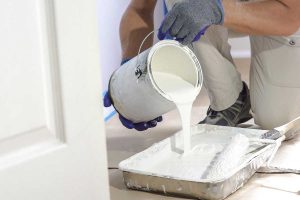Painting your walls may seem like an easy task, but if you factor in your research and the actual painting, freshening up your room actually takes time and effort.
Most painting jobs can take up your entire weekend to finish. So wouldn’t you be disappointed if you find paint streaks in what should be a smooth finish?
To help you avoid making this painting mistake, below is a list of reasons why paint streaks can appear and a quick guide on how to fix them.
What causes streaks when painting?
Paint streaks can be frustrating because you’ll only usually spot them when the paint is dry. When you thought you’ve done a good job of painting your walls, these marks will remind you of the complete opposite. If you’re wondering how this mistake can happen, here are a few possible reasons that will help you determine:
Thick or uneven paint
The most common reason why paint streaks appear is when you’re applying thick coats of paint on the wall. Since it’s easy to load up too much paint on rollers, combined with excess pressure will lead the paint to squeeze into the sides. If left unnoticed, they may leave a set of lines on the wall instead of a smooth finish.
Another case is applying a thick first layer of paint and didn’t allow it to dry completely. Since thicker coats take longer to dry, applying a second layer on wet and gummy paint will guarantee roller marks or brush strokes to show up.
Unprepped walls
If you think you can get away with painting over old stains and cracks, know that that will be a bad idea since they could be the reason why your wall has paint streaks. Painting pros know that it’s always recommended to prep and prime your walls before painting since this is the foundation to get a professional finish.
So fill in any holes and cracks with spackle or joint compound and sand away any rough textures. Then wipe the walls with a damp towel to remove any dust before applying primer. The primer will fill in any uneven patches and ensure the paint will adhere better to the surface.
Poor painting technique
If you think applying paint in any direction will allow you to cover the area faster, you might want to rethink your technique since this will surely result in streaks.
It’s best to apply the paint in one direction to ensure it’s smooth and even. If you’re using a roller, make sure to apply it on a ‘W’ pattern while using light pressure. Then overlap each pattern 50% until you cover the walls completely.
Low-quality paint and tools
Even when you’re using the proper painting technique, the paints and tools you’re using can be the cause of your project’s downfall. Cheaper paint and paintbrushes may allow you to cut down on a few bucks, but the savings are sometimes not worth it when you’re getting subpar results.
That’s because low-quality paint tends to have a thinner consistency compared to high-quality ones, so you’ll be forced to apply a thicker coat just to cover the walls. Budget-friendly paintbrushes and rollers are also no better since their materials tend to be too stiff to apply the paint smoothly and evenly.
How do you fix streaks on painted walls?
If you’re too late and the damage is done, there are a still couple of methods you can do to eliminate the paint streaks:
Method #1: Sand away the streaks
There’s a reason why sanding walls are recommended before painting since this will ensure they’re smooth enough for a flawless finish.
You can apply this same technique for thick or raised paint streaks since this will even out the surface. Since streaks can sometimes be clumped paint or rolled dust, sanding them will help them separate from the surface. Do take note that you should only do this when the paint is completely dry to avoid creating more streaks.
Once all of the streaks are gone, apply another layer of paint and let it dry completely.
Method #2: Apply a second coat
If you’re seeing inconsistent color streaks on the walls, you can still cover them up by applying another layer of paint. But this time you’ll need to make sure you won’t over or underload the roller or brush and use uniform pressure when painting.
Pouring the paint into a tray will help ensure you’ll load the roller evenly. To do this, dip it lightly into the tray and roll it back and forth a few times to uniformly distribute the paint.
If you’re using a paintbrush, wipe both sides of the brush to the edge of the paint bucket to remove any excess. If the paintbrush is dripping, you’ll know there’s too much paint on its bristles.
Tips for painting walls to prevent streaks
If you’re still nervous about creating streaks when painting your walls, you can keep these tips and tricks in mind to help you get a smooth surface:
- Always use high-quality paint and brushes to ensure the coats will apply smoothly. Only use long and even strokes when painting, and avoid going over painted surfaces to avoid creating brush streaks.
- Make sure to mix the paint beforehand to ensure the colors are even and there aren’t any floating sediments.
- Avoid leaving wet brushes or rollers out in the open if you’re not using them since this will cause the paint to dry up. Wrap them in plastic wrap and place them in an airtight bag. Store the brush in the fridge to keep the paint fresh so they’re ready to use the next day.
- Keep the room you’re painting well-lit so you could see your painting progress and spot any streaks before they dry up.
Looking for a reliable painting contractor?
If you’re considering giving your home a color makeover but are afraid of getting paint streaks, Soho Painters can do it for you. Armed with the best tools and materials, you can trust our experienced painters to transform your walls with a professional finish. Whether you need commercial or apartment painting, contact our team now to book a free estimate.





